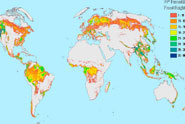20 July 2010
WASHINGTON—Using satellite data, scientists have produced a first-of-its kind map that details the height of the world’s forests. Although there are other local- and regional-scale forest canopy maps, the new map is the first that spans the entire globe based on one uniform method.
The map, based on data collected by NASA’s ICESat, Terra, and Aqua satellites, should help scientists build an inventory of how much carbon the world’s forests store and how fast that carbon cycles through ecosystems and back into the atmosphere.

Global forest height map. Heights are the 90th percentile of GLAS height observations within a patch.
IMAGE CREDIT: Michael Lefsky
[ Full-size image 88k ]
“This is a really just a first draft, and it will certainly be refined in the future,” said Michael Lefsky, the remote sensing specialist from Colorado State University who made the map. Lefsky described his results in a scientific report that has been accepted for publication in Geophysical Research Letters, a journal of the American Geophysical Union.
The forest-height map has implications for an ongoing effort to estimate the amount of carbon tied up in Earth’s forests and for explaining what sops up 2 billion tons of “missing” carbon each year. Humans release about 7 billion tons of carbon annually, mostly in the form of carbon dioxide. Of that, 3 billion tons end up in the atmosphere and 2 billion tons in the ocean. It’s unclear where the last two billion tons of carbon go, though scientists suspect forests capture and store much of it as biomass through photosynthesis.
“What we really want is a map of above-ground biomass, and the height map helps get us there,” said Richard Houghton, an expert in terrestrial ecosystem science and the deputy director of the Woods Hole Research Center.
Lefsky used data from a laser technology called LIDAR that’s capable of capturing vertical slices of surface features. It does so by shooting pulses of light at the surface and observing how much longer it takes for light to bounce back from the ground surface than from the top of the canopy. Since LIDAR can penetrate the top layer of forest canopy, it provides a fully-textured snapshot of the vertical structure of a forest—something that no other scientific instrument can offer.
Lefsky based his map on data from more than 250 million laser pulses collected during a seven-year period. Each pulse returns information about just a tiny portion of the Earth’s surface, so the project completed direct LIDAR measurements of only 2.4 percent of the planet’s forested surfaces. To complete the map, Lefsky combined the LIDAR data with information from the Moderate Resolution Imaging Spectroradiometer (MODIS), a satellite instrument aboard both the Terra and Aqua satellites that senses a much broader swath of Earth’s surface, even though it doesn’t provide the vertical profile.
The next generation LIDAR measurements of forests and biomass, which will improve the resolution of the map considerably, could come from NASA’s Deformation, Ecosystem Structure and Dynamics of Ice (DESDynI) satellite, proposed for the latter part of this decade.
Joint Release
American Geophysical Union
National Aeronautics and Space Administration
Colorado State University
AGU Contact:
Kathleen O’Neil, +1 (202) 777-7524, [email protected]
NASA Contact:
Steven Cole, +1 (202) 358-0918, [email protected]
CSU Contact:
Kimberly Sorensen, +1 (970) 491-0757, [email protected]
As of the date of this press release, the paper by Walter et al. is still “in press” (i.e. not yet published). Journalists and public information officers (PIOs) of educational and As of the date of this press release, the paper by Lefsky is still “in press” (i.e. not yet published). Journalists and public information officers (PIOs) of educational and scientific institutions who have registered with AGU can download a PDF copy of this paper in press.
Or, you may order a copy of the paper by emailing your request to Kathleen O’Neil at [email protected]. Please provide your name, the name of your publication, and your phone number.
Neither the paper nor this press release are under embargo.
“A global forest canopy height map from MODIS and the Geoscience Laser Altimeter System”
<strongMichael Lefsky, Colorado State University, Fort Collins, Colorado, USA.
Michael Lefsky +1(970) 491-0602; [email protected]